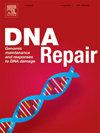泛素与PCNA的可逆结合对于酿酒葡萄球菌的模板转换是重要的
IF 2.7
3区 生物学
Q2 GENETICS & HEREDITY
引用次数: 0
摘要
复制因子PCNA的多泛素化通过无错误的模板转换途径激活DNA病变的复制旁路。然而,k63连接的多泛素链促进损伤旁路的机制尚不清楚。有趣的是,线性泛素低聚物与PCNA的稳定融合,被设计成原生k63链的模拟物,是没有功能的,而用线性链修饰PCNA的酶促修饰支持出芽酵母中的模板转换。为了研究这种差异的原因,我们采用了另一种方法来确定激活损伤旁路所必需的多泛素化PCNA的特征。我们设计了线性的,不可切割的泛素结构,可以通过PIP基序非共价地招募到PCNA。我们发现这些部分抑制了PCNA泛素化缺陷酵母菌株的损伤敏感性和自发突变率的升高。遗传分析证实,这种拯救是由于模板转换途径的激活。令人惊讶的是,在这种情况下,即使单泛素单位的招募也会促进活动。这些观察结果表明,泛素与PCNA结合的可逆性比多泛素链的实际连接更重要。因此,我们的研究强调了泛素信号在DNA损伤旁路背景下的动态性质。本文章由计算机程序翻译,如有差异,请以英文原文为准。
Reversible association of ubiquitin with PCNA is important for template switching in S. cerevisiae
Polyubiquitylation of the replication factor PCNA activates the replicative bypass of DNA lesions via an error-free pathway involving template switching. However, the mechanism by which the K63-linked polyubiquitin chains facilitate damage bypass is poorly understood. Intriguingly, stable fusions of linear ubiquitin oligomers to PCNA, designed as mimics of the native K63-linked chains, are not functional, while enzymatic modification of PCNA with linear chains supports template switching in budding yeast. To investigate the cause of this discrepancy, we have taken an alternative approach to identify the features of polyubiquitylated PCNA essential for activating damage bypass. We designed linear, non-cleavable ubiquitin constructs that can be recruited non-covalently to PCNA via a PIP motif. We found that these partially suppress the damage sensitivity and elevated spontaneous mutation rates of yeast strains defective in PCNA ubiquitylation. Genetic analysis confirms that this rescue is due to an activation of the template switching pathway. Surprisingly, even the recruitment of monoubiquitin units promotes activity in this setting. These observations suggest that the reversibility of ubiquitin’s association with PCNA is more important than the actual linkage of the polyubiquitin chain. Thus, our study highlights the dynamic nature of ubiquitin signaling in the context of DNA damage bypass.
求助全文
通过发布文献求助,成功后即可免费获取论文全文。
去求助
来源期刊

DNA Repair
生物-毒理学
CiteScore
7.60
自引率
5.30%
发文量
91
审稿时长
59 days
期刊介绍:
DNA Repair provides a forum for the comprehensive coverage of DNA repair and cellular responses to DNA damage. The journal publishes original observations on genetic, cellular, biochemical, structural and molecular aspects of DNA repair, mutagenesis, cell cycle regulation, apoptosis and other biological responses in cells exposed to genomic insult, as well as their relationship to human disease.
DNA Repair publishes full-length research articles, brief reports on research, and reviews. The journal welcomes articles describing databases, methods and new technologies supporting research on DNA repair and responses to DNA damage. Letters to the Editor, hot topics and classics in DNA repair, historical reflections, book reviews and meeting reports also will be considered for publication.
 求助内容:
求助内容: 应助结果提醒方式:
应助结果提醒方式:


